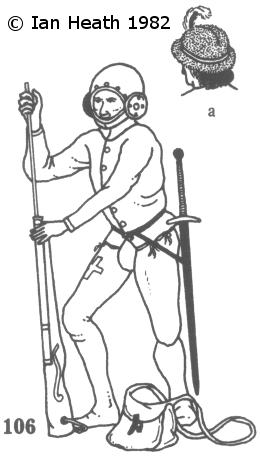|
|

SWISS HANDGUNNER, BURGUNDIAN WARS
An extract from Armies of the Middle Ages, volume 1
by Ian Heath
106. SWISS HANDGUNNER, BURGUNDIAN WARS
Firepower in Swiss armies was provided by crossbowmen and, later, handgunners, collectively called by the term schützen.
One of the earliest references to the use of handguns by the Swiss dates back to 1385-86, when they were used during the siege and capture of Rothenburg in the Sempach war,
and there are further allusions to their use in 1388 and 1393.
In the mid-15th century the proportion of handgunners to crossbowmen was roughly 1:8, but by the time of the Burgundian Wars this had levelled off to approximately 1:1.
One source even claims that there were 6,000 handgunners at Morat in 1476. Certainly there were at least 800 at Nancy.
The figure depicted here, from Schilling's 'Berne Chronicle', is noteworthy in particular for the early portrayal of a ramrod being used.
The crooked device on the butt of the gun is also interesting, apparently being
a serpentine (see 114)
in which case some early sort of trigger mechanism is here in use,
probably a push-button release. The satchel may have held both powder and shot, though some pictures show small powder flasks being carried.
On the march the gun was carried across the shoulder by the barrel with the satchel slung over the butt.
To judge from the source the helmet he wears, with roundels and bevor, was a very popular type. Others wore chapeaux-de-fer or visored sallets, or else fur or felt caps like 106a.
Swiss crossbowmen invariably used the cranequin or rack mechanism to span their weapons, both on horseback and on foot.
Though it was the slowest spanning device it was favoured over the windlass because it was considerably less cumbersome.
By the time of the Burgundian Wars Swiss crossbowmen were also unencumbered by pavises.
Next: 107. SWISS MUSICIAN, 15th CENTURY, in Armies of the Middle Ages, volume 1 by Ian Heath
|

